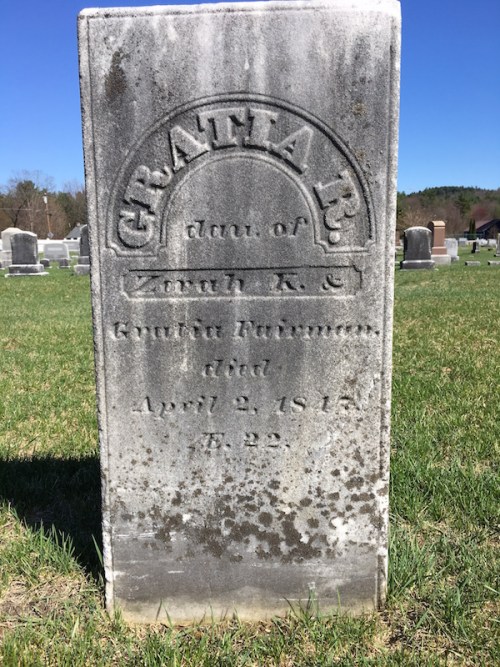One heart beats warm for me: A 19th century Vernon tragedy, with a long epilogue
By Barbara Emery Moseley
Nearly a century after they were written, the Vernon Historians received a packet of letters from a member of the family that treasured them for several generations. Although the ink is a bit faded, the elegant cursive handwriting reveals a poignant love story.
Written before the Civil War, they disclose the death from cholera of 22-year-old Gratia (pronounced Gray-sha) Fairman in 1847. They are from her fiancé, William H. Burt, who worked in Worcester, living there in a men’s boarding house.
Gratia’s brother George had notified him that she was sick in bed with a fever. Burt responded in a letter to Gratia: “It will be my constant prayer that you may soon recover . . . if you should become dangerously ill or materially worse, let me know it and I will soon be with you. I am enjoying my usual good health.”
Gratia’s condition deteriorated rapidly, however. She was in pain, but “she bore her suffering patiently, and calmly resigned herself into the hand of a kind Father who has promised never to forsake his children.”
Those words were from Professor John S. Lee, her mentor and teacher at Mt. Caesar Academy in Swanzey, N. H. (Born on West Road in Vernon, his life of distinction will be told another time.)
On his return to Worcester, after the funeral, Burt wrote to her family, “to find some relief from my anguish . . . there is no sympathy here for those who mourn.” He continues: “Not a day has since passed but I have found my relief in tears, my pillow is often moistened with them at night. Many times have I wished I might never see the sun rise again — I have lived long enough — my cup of bitterness is full. What more of affliction life has in store for me I know not . . . All is gone . . . Wherever I was, in whatever circumstances I was placed, I was sure there was one heart beat warm for me. Death, welcome Deliverer, come to me next.”
No more letters from Burt were in the packet. Did the Deliverer come?
Postscript by Martin Langeveld:
With the benefit of an internet search, we can now report that William H. Burt was in fact delivered from the sorrows of losing Gratia, and lived a long and illustrious life. In a volume entitled Genealogy of the descendants of John White of Wenham and Lancaster, Massachusetts, 1638-[1909] (Volume 2) by Almira Larkin White, we find an extensive biography as follows (with a few edits and notes for clarity):
Lieut.-Col. WILLIAM H. Burt, born in Westmoreland, N. H., May 24, 1824; married (1) Oct., 1848, Hannah L. Williams of Amherst, Mass., who died May 8, 1852. He married (2) Nov. 8, 1855, Ann Louisa Davis of Dublin, N. H., who is now [1909] living in Keene, N. H.
He passed his early years on the farm, and enjoyed such advantages for education as were provided by the common schools, supplemented by a few terms in Mt. Caesar Academy in Swanzey, N. H. [Note: Gratia also attended this school, which is where they must have met.] He cherished a hope to become qualified for a professional life, either at medicine or law, and directed all his energies to that purpose, but often found the way obscure and discouraging, yet by perseverance he realized his anticipations. He studied law in the office of Hon. Levi Chamberlain in Keene, N. H., and afterward with Gen. James Wilson, formerly of Keene, in San Francisco, Cal., where he was admitted to practice as Attorney and Counselor-at-Law, Feb. 9, 1854, and returned to his native state in Nov., 1855. In the spring of 1856, he went to Minnesota, then a territory, where he engaged in business as a lawyer in Stillwater, and important interests were placed in his care. He was a member of the legislature of Minnesota in 1861-2.
Under the urgent call of President Lincoln, for 600,000 men to reinforce the Union army in August, 1862, he joined the military service. As a recruiting officer for the Seventh Minnesota Regiment Infantry he enlisted a full company of men in five days, and reported forthwith in Fort Snelling, Minn., for duty. He was elected captain and directly given the command of his own Company C and Company I, with orders to move directly to Fort Ripley, Minn., to assist in the defense of that post against Chippewa Indians, who were then harassing the settlers of that frontier.
Soon a “Council of Peace,” of which Capt. Burt was a member, was convened, whereby peaceful relations were resumed with that tribe, through their Chiefs, and his command (Company C and Company I) was ordered to join their regiment, which had been protecting other parts of the state, suffering from the depredations and cruelties of the Sioux Indians, and were then in Mankato, Minn. His detachment arrived there Nov. 23, and was assigned to duty as guard of the Sioux prisoners, three hundred of which had been sentenced to close confinement, and thirty-nine to death, by a military commission.
[Note: this conflict with the Sioux became known at the Dakota War of 1862, and was a particularly violent episode in the long history of North American frontier wars, with 490 white settlers killed along with a large number of Native Americans. At its end, according to Wikipedia, “303 Sioux prisoners were convicted of murder and rape by military tribunals and sentenced to death. Some trials lasted less than 5 minutes. No one explained the proceedings to the defendants, nor were the Sioux represented by defense attorneys. Pres. Abraham Lincoln personally reviewed the trial records to distinguish between those who had engaged in warfare against the U.S., versus those who had committed crimes of rape and murder against civilians. . . . In the end, Lincoln commuted the death sentences of 264 prisoners, but he allowed the execution of 38 men.” (Originally 39 were scheduled to be executed, but the life of one more was spared on the day of the hangings because of discrepancies in the testimony that convicted him. For a more extensive account of the executions, see this account originally published in the New York Times. This simultaneous execution of 38 men still stands as the largest mass execution in United States History. ]
Company C was given the post of honor on the day of execution, Dec. 26, 1862, and Capt. Burt as “officer of the day ” received much credit for his services.
Again he, with his company, were called upon to perform the somewhat perilous duty of escorting the three hundred Indian prisoners, in the spring of 1863 to Rock Island, 111. by steamboat, and returning they joined in the summer campaign against the Sioux in Dakota. With a small detachment Capt. Burt was ordered to Devil’s Lake to reconnoiter for stray Indian bands, and there captured Wowinapa, the son of Little Crow, the powerful Sioux Chief, in the massacre of 1863 in Minnesota.
The entire command of Gen. Sibley returned to Fort Snelling, Sept. 16, 1863, and the Seventh Minnesota regiment was soon ordered south to aid in the great work of suppressing the Rebellion. In St. Louis they were retained during the winter for guard and escort duty. Here Capt. Burt received a commission as major of his regiment, dated Nov. 6, 1863. In April, the regiment was sent forward to Paducah, Ky., thence, June 19, was ordered to Memphis, and assigned to the ” Third Brigade, First Division, Sixteenth Army Corps,” under Gen. A. J. Smith.
From this time, for this regiment, the service was very hard ; long marches, coupled with severe deprivations and frequent engagements with the Confederate army, following the fortunes of “The Sixteenth Army Corps,” which was expected to hasten hither and thither, to strengthen the forces of every Union general in want of troops, often taking the brunt of the battle upon their arrival. Thus going from Memphis to Tupelo, Miss., Oxford and Tallahatchie, to Arkansas and Missouri, by forced marches pursuing the Confederate General Price and his command through mud and snow, fording icy rivers, hungry and weary, reaching St. Louis and hurried on to assist General Thomas in his great battles at Nashville, Tenn., Dec. 15 and 16, 1864, following Hood in his flight through Tennessee; then to Eastport, Miss., and New Orleans, and on to Dauphin Island, where the 16th Army Corps was reorganized for the great siege of Mobile, arriving there March 20, 1865. They were at once sent forward to invest the Spanish Fort, which was reduced Apr. 8, 1865. The Seventh Minnesota regiment, under Major Burt, did garrison duty from that time till July 20, at Montgomery and Selma, Ala., when they started homeward and were mustered out of the military service at Fort Snelling, Minn., Aug. 16, 1865.
Originally possessed of a strong constitution, the exposures of army life, during three years of continuous active duty as a soldier, exhausted the vitalit}’ of Major Burt, causing an illness from which he did not recover. He died Mar. 15, 1866, at Worcester, Mass., at the home of his only surviving sister, leaving a widow. His military services were highly appreciated by his superior officers. He received the commission of Brevet Lieutenant Colonel United States Volunteers, from President Johnson, for gallant and meritorious service at the siege of Spanish Fort, Mobile Harbor, Ala.

